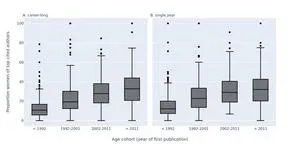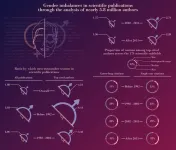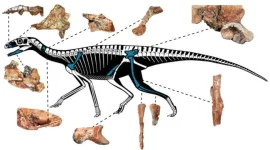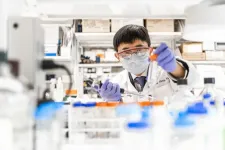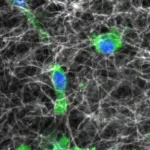(Press-News.org) TORONTO, Nov. 21, 2023 – Faced with images that break the expected pattern, like a do not enter sign where a stop sign is expected, how does the brain react and learn compared to being shown images which match what was predicted?
That was the question a team, including York University, set out to answer. A long-standing theory suggests the brain learns a predictive model of the world and its internal predictions are updated when incoming sensory data proves them wrong. However, what the researchers found surprised them, says York Faculty of Science Associate Professor Joel Zylberberg, co-corresponding author of the newly published paper.
“Testing this theory has always been a challenge,” he says. “We needed to be able to measure the top-down signals to the sensory areas of the brain over long periods of time to show how the brain learns new sensory input patterns.”
Using a mouse model, the researchers displayed images of visual patterns over multiple days, then presented other images that violated those patterns, while measuring the brain’s activity in the visual cortex, where visual information from the retina is processed. The idea was to test how the neurons reacted to the new pattern-violating sensory information.
Several of the researchers, including Zylberberg, are Fellows in the Canadian Institute for Aadvanced Research’s Learning in Machines and Brains group, which conducted the research as part of the Allen Institute for Brain Science’s Brain Observatory and its OpenScope program. OpenScope has been compared to an observatory where astronomers work together to study the universe, only this time researchers are sharing data to study the brain.
The measurements were taken at the neurons’ distal apical dendrites of the visual cortex, which receive top-down signals, and at their cell bodies, which receive bottom-up signals. They wanted to know if the distal apical dendrites processed visual stimuli differently from their cell bodies when the signals both matched and violated expected patterns.
It turns out, the brain’s response to image patterns that violate the brain’s predictions, evolves differently over time when compared to pattern-matching images.
“Surprisingly, the distal apical dendrites responses grew significantly over time becoming increasingly sensitive to inputs that violate the patterns, while the cell bodies lost their initially strong sensitivity,” says Zylberberg, a computational neuroscientist. “This finding could offer critical insight into sensory computation and predictive learning in the brain.”
The finding suggests that the pattern-violating stimuli drove the changes and different forms of pattern-violating stimuli may elicit different kinds of prediction errors than expected. It points to a component of the brain that could have a distinct and important role in sensory learning not previously known.
“Knowing how the brain processes new visual sensory information is important for developing better machine learning algorithms and applications which could hopefully help restore people’s sight in the future,” says Zylberberg.
The paper, Responses to pattern-violating visual stimuli evolve differently over days in somata and distal apical dendrites, was published today in JNeurosci, the Journal of Neuroscience.
END
Researchers help unravel brain processes involved in vision
2023-11-21
ELSE PRESS RELEASES FROM THIS DATE:
Unearthing how a carnivorous fungus traps and digests worms
2023-11-21
A new analysis sheds light on the molecular processes involved when a carnivorous species of fungus known as Arthrobotrys oligospora senses, traps and consumes a worm. Hung-Che Lin of Academia Sinica in Taipei, Taiwan, and colleagues present these findings November 21st in the open access journal PLOS Biology.
A. oligospora usually derives its nutrients from decaying organic matter, but starvation and the presence of nearby worms can prompt it to form traps to capture and consume worms. A. oligospora is just one of many species of fungi that can trap and eat very small animals. Prior research has illuminated some of the biology behind this ...
Taxing sugar-sweetened beverages in Germany would improve population health and save money
2023-11-21
In Germany, taxing sugar-sweetened beverages could prevent or postpone cases of type 2 diabetes, extend healthy lifespans and save up to €16.0 billion in societal costs over the next 20 years, according to a new study led by Karl Emmert-Fees of the Technical University of Munich, published November 21st in the open access journal PLOS Medicine.
The World Health Organization has recommended that governments worldwide lessen the social and economic burden of cardiometabolic disease by taxing sugar-sweetened beverages. These taxes either reduce consumption by increasing the price, such as the one peso per liter ...
Germany: Sugar tax could save as much as 16 billion euros
2023-11-21
A simulation study conducted by a team from the Technical University of Munich (TUM) demonstrates that a soft drink tax in Germany would have significant positive effects. In all of the simulated variants evaluated, less sugar was consumed and the rate of illness dropped. This would be a way to reduce costs to the national economy and alleviate the burden on the health care system. There is, however, a difference between taxes aimed at reducing soft drink consumption and taxes aimed at bringing about changes in product formulation.
Sugary beverages increase the risk of obesity and illnesses such as diabetes. Several countries have therefore introduced taxes on soft drinks. In Germany ...
Most-cited scientists: still mostly men, but the gender gap is closing
2023-11-21
An analysis of 5.8 million authors across all scientific disciplines shows that the gender gap is closing, but there is still a long distance to go. The new research by John Ioannidis of the Meta-Research Innovation Center at Stanford (METRICs) at Stanford University, US, and colleagues, publishes November 21st in the open access journal PLOS Biology.
There is a strong gender gap in science which manifests itself in many ways. One of the most prominent ones is the relative representation of men and women among the scientists whose work receive the most attention in the ...
New fossil assemblage highlights complexity of classifying silesaurid phylogeny
2023-11-21
A set of fossils recovered in Rio Grande do Sul, Brazil’s southernmost state, has brought an extra layer of complexity to the study of the evolutionary history of silesaurids, a family of dinosauriforms (dinosaurs and their close relatives) that lived in the Triassic period between 247 million and 208 million years ago.
In an article published in the Journal of Vertebrate Paleontology, researchers affiliated with institutions in Brazil and the United States show that even with the new fossil assemblage ...
CRF launches Scientific Excellence Top 10 (SET-10)
2023-11-21
NEW YORK – November 20, 2023 – The Cardiovascular Research Foundation (CRF), in conjunction with the Transcatheter Cardiovascular Therapeutics (TCT) 2023 conference, CRF's annual scientific symposium, announced today the launch of the CRF Scientific Excellence Top 10 (SET-10), a new global annual ranking recognizing academic contributions to interventional cardiovascular medicine.
The SET-10 initiative, aligning with CRF's commitment to advancing the field, aims to recognize and celebrate the extraordinary contributions made by medical and academic ...
Cleveland Clinic research finds sex differences in immune response and metabolism drive Alzheimer’s disease
2023-11-21
Tuesday, Nov. 21, 2023, CLEVELAND: Cleveland Clinic researchers analyzed genes and brain tissue of patients with Alzheimer’s and found that differences in brain immunometabolism – the interactions between the immune system and the ways cells create energy – may contribute to women’s increased risk for the disease and its severity.
The findings, published in Alzheimer’s and Dementia, offer important insight into developing sex-specific treatment and prevention options for Alzheimer’s disease, the sixth-leading ...
Hearing loss is associated with subtle changes in the brain
2023-11-21
Hearing loss affects more than 60 percent of adults aged 70 and older in the United States and is known to be related to an increased risk of dementia. The reason for this association is not fully understood.
To better understand the connection, a team of University of California San Diego and Kaiser Permanente Washington Health Research Institute researchers employed hearing tests and magnetic resonance imaging (MRI) to determine whether hearing impairment is associated with differences in specific brain regions.
In the November 21, 2023 issue of the Journal of Alzheimer’s Disease, researchers reported that individuals enrolled in this observational ...
Long in the Bluetooth: Sussex scientists develop a more efficient way to transmit data between our devices
2023-11-21
University of Sussex researchers have developed a more energy-efficient alternative to transmit data that could potentially replace Bluetooth in mobile phones and other tech devices. With more and more of us owning smart phones and wearable tech, researchers at the University of Sussex have found a more efficient way of connecting our devices and improving battery life. Applied to wearable devices, it could even see us unlocking doors by touch or exchanging phone numbers by shaking hands.
Professor Robert Prance and Professor Daniel ...
Discovering communications mechanisms between cells
2023-11-21
Day by day, we communicate with our office colleagues to accomplish tasks that are necessary to function. The more than 200 different types of cells in our bodies do the same thing, but the way they communicate with each other isn't as simple as sending an email.
Researchers like Ioannis Zervantonakis are still trying to understand how these cells actually communicate with each other. The assistant professor of bioengineering at the University of Pittsburgh Swanson School of Engineering recently received a National Institute of General Medical Sciences Maximizing Investigators' Research Award, and his project ...

